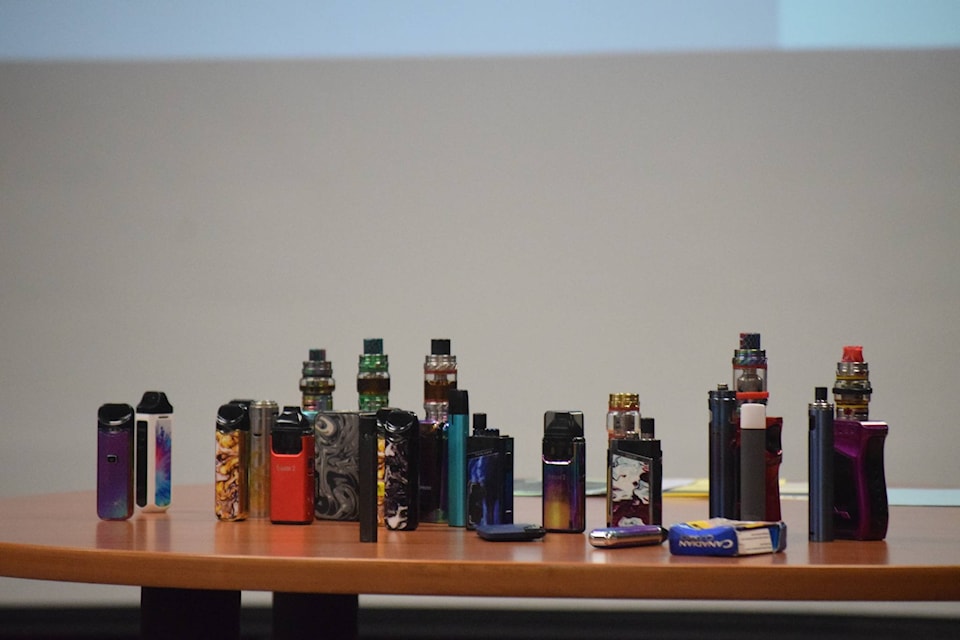Smithers Secondary School (SSS) wants students to know that vaping can be a real drag.
At a Nov. 26 presentation put on by the SSS principal Jaksun Grice, vice principal Dustin Hersee and drug and alcohol prevention worker Inderjit Grewal at the school’s library, the team discussed both the rise of vaping among teenage populations at school.
The presentation was inspired by recent health revelations about vaping juices being blamed for numerous deaths across North America and a rise of conditions thought to be vape-related like bronchiolitis obliterans, also known as Popcorn lung, an inflammatory condition that affects the bronchioles in the lungs.
“It’s kind of the new-age smoking,” said Grice, discussing the recently-emerging trend of heating up nicotine-laden juices filled with a number of obscure (and often unregulated) chemicals to the point of vaporization in a number of different handheld devices.
The juices used in vaporizers often contain tobacco, but they can also contain cannabinoids such as tetrahydrocannabinol, cannabidiol and various terpenes and flavinoids found in cannabis.
READ MORE: Revelstoke high school starts ‘buy-back’ program for vapes
Vaporizers can range from less than $20 for simple, disposable units or up to thousands for a complex, state-of-the-art unit.
Relatively new to the scene, Grice said vapes were essentially unheard of within SD54 (or just about any district) community up until the last half decade or so.
However that changed, with Grice noting a marked increase in vaping use across the country.
SSS, he said, is no different.
“Last year we did a couple of surveys on our kids … and that showed [60 per cent of] SSS respondents had tried vaping.”
Grice noted SSS did an additional quick internal survey which found usage among students to be as high as 70 per cent.
As part of the increase, the school had to remove the front doors to the bathrooms (but not the stall doors themselves) in an attempt to crack down on students who had been vaping the relatively (compared to cigarettes) less pungent vaping products.
Another problem Grice discussed is the issue of students having easy access to vaporizers, noting what many students will do is buy a prepaid VISA credit card and order devices and juices online, or pool money together and have an adult place an order for them.
He noted for many parents it’s a perspective of being happy their child is not smoking, but adds that he feels with all the recent news about vape-related illnesses he feels this is starting to change.
The meeting also focused on how SSS is offering support to students who vape, specifically concerning how they provide them with both counsellor support (via sessions with Grewal) and individual support tailored to their specific situation on how they can formulate a plan that works within their lives to quit vaporizing.
For Grewal’s part, she said her role is a little bit different than administration. Grice noted vaping on SSS property does trigger an automatic in-school suspension. Grewal’s interaction with students is based more on an empathetic ground and building a one-to-one foundational relationship with students.
“I take a step back because first you have to have a trust with these students, because once that’s lost then it’s not going to work.”
It’s Grewal’s sixth year with the school.
READ MORE: 73% of B.C. residents agree with a temporary ban on vaping products
She said while a small minority of students she sees need clinical intervention to help them with their issues, the vast majority can use a variety of therapeutic methods to be successful in quitting vaping.
One of those is QuitNow, a provincial initiative aimed at educating people on how to quit smoking or vaping.
“Last month there were 17 students that I was seeing and 15 them successfully completed it and the two of them are still going back and forth until they’re ready.”
Lastly she noted it’s important to be empathetic and understanding of a teenager’s situation, noting it’s a time in many people’s lives where they explore and learn a lot about themselves.
“We try not to be judgmental … some of these kids come from homes where there is not much support so this five, six hours at school are very crucial for them.
“I think it’s OK to experiment as long as we get back on track, so in a nutshell we are just here to support and get them back on track.”
trevor.hewitt@interior-news.com
Like us on Facebook and follow us on Twitter
